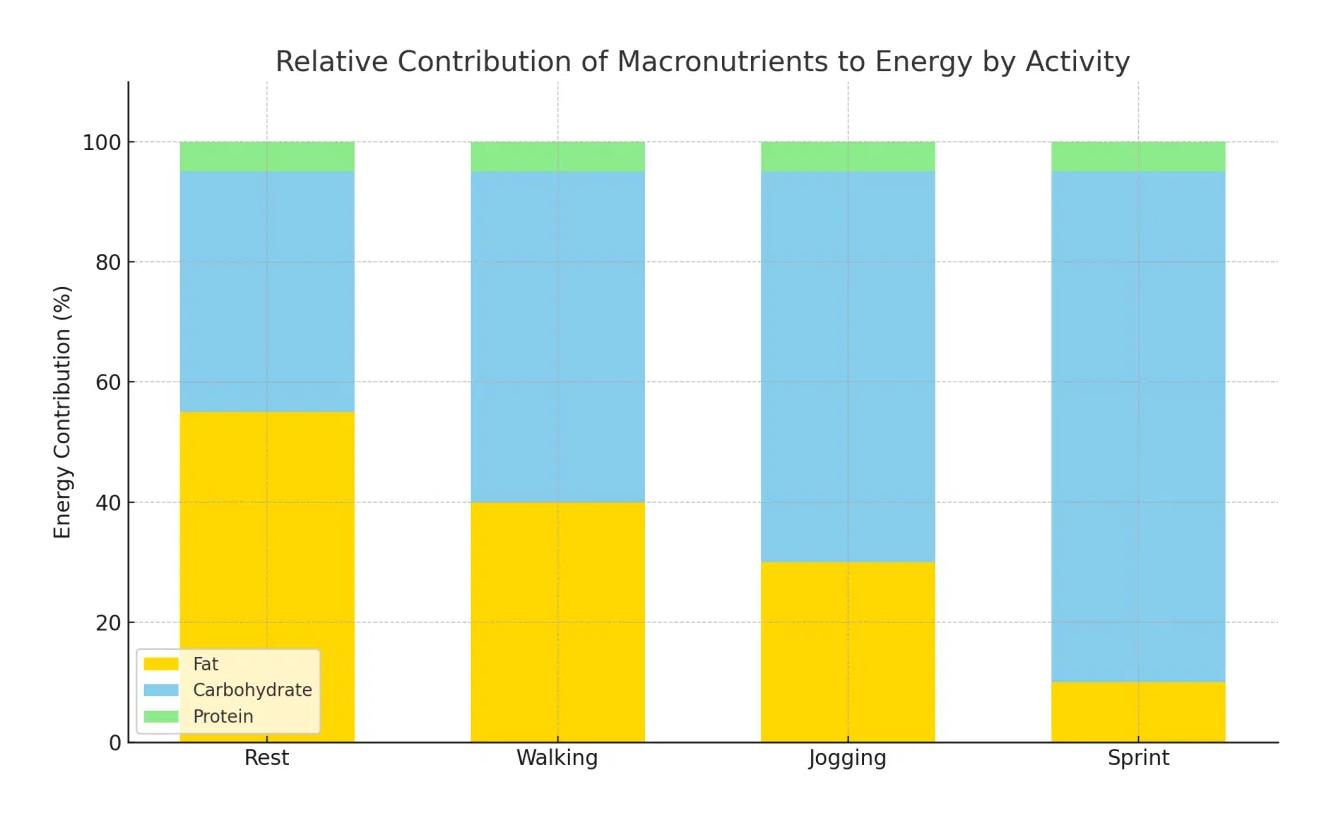Practice A.2.2 Fuelling for health and performance with authentic IB Sports, exercise and health science (SEHS) exam questions for both SL and HL students. This question bank mirrors Paper 1A, 1B, 2 structure, covering key topics like core principles, advanced applications, and practical problem-solving. Get instant solutions, detailed explanations, and build exam confidence with questions in the style of IB examiners.
Which athlete is most likely limited in aerobic performance due to inadequate oxygen transport?
| Athlete | Iron (µg/dL) | VO₂max (mL/kg/min) |
|---|---|---|
| A | 72 | 61 |
| B | 33 | 45 |
| C | 55 | 57 |
| D | 67 | 60 |
Athletes completed 120 minutes of cycling at 70% VO₂max after following a high-carbohydrate or high-fat diet for 5 days. Figure 1 shows the estimated contribution of fat, muscle glycogen, and plasma glucose oxidation in each condition.
In a separate trial, Figure 2 compares the hourly energy contribution (kcal/hour) of carbohydrates, proteins, and fats during low- and high-intensity exercise.
Researchers explored how macronutrient intake and exercise intensity influence substrate preference and energy efficiency.
Figure 1: Substrate Oxidation After 5-Day High-CHO vs High-Fat Diet
Figure 2: Macronutrient Contribution by Exercise Intensity
Using Figure 1, describe how the oxidation of fat and muscle glycogen differs between the high-carbohydrate and high-fat diets.
Refer to Figure 1. Calculate the total carbohydrate oxidation (plasma glucose + muscle glycogen) in grams for each diet condition.
Using your answer, explain the potential advantage of high-fat adaptation on glycogen sparing.
Refer to Figure 2. Identify which macronutrient shows the greatest absolute change in energy contribution between low- and high-intensity exercise.
Explain how this reflects a metabolic shift in substrate utilization and efficiency.
Outline one advantage of a high-carbohydrate diet for performance and one disadvantage of prolonged high-fat diets in endurance athletes.
A survey was conducted on athletes' nutritional habits before and after workouts. Participants reported all food types they typically consumed, categorized as carbohydrates, protein, fruits and vegetables, dairy, and other. Data were analyzed separately by sex and workout timing (pre vs. post).
Four pie charts (A–D) show food group selections as percentages of all responses, not individuals. Additionally, researchers recorded the average number of food items selected per athlete per session, shown in the table below.
Table: Average Number of Food Items Selected Per Athlete (± SD)
| Group | Pre-Workout | Post-Workout |
|---|---|---|
| Female Athletes | 2.4 ± 0.6 | 2.1 ± 0.5 |
| Male Athletes | 2.8 ± 0.7 | 2.3 ± 0.4 |
Figure: Food Types Selected Pre- and Post-Workout (% of total responses)
A: Females – Pre-workout
B: Females – Post-workout
C: Males – Pre-workout
D: Males – Post-workout
Identify the food type with the highest percentage of selections in male athletes post-workout.
Describe two key changes in food group preference between female athletes pre- and post-workout.
State one physiological reason why male athletes may prefer higher carbohydrate intake before exercise.
Use Table 1 to calculate the average reduction in the number of food items selected from pre- to post-workout for each sex.
Suggest how a reduced variety of food items post-workout might influence macronutrient balance or recovery.
Explain how protein consumption after training supports exercise recovery and muscle adaptation.
Considering the pie chart data, evaluate whether post-workout protein intake appears adequate for both sexes.
Evaluate how inadequate macronutrient intake relative to energy expenditure could increase the risk of Low Energy Availability (LEA) or Relative Energy Deficiency in Sport (RED-S). Use evidence from the chart and table to support your explanation.
State two functions of potassium in exercise physiology.
Identify two consequences of excessive water intake without electrolyte replacement.
Describe the process of osmoregulation during prolonged exercise.
Explain how thermoregulation is influenced by hydration status.
Outline two adaptations in trained endurance athletes that improve fluid and electrolyte efficiency.
Discuss the physiological effects of chronic dehydration on athletic performance and recovery.
State one function of water in the human body and one way it is lost.
Identify two symptoms of mild dehydration.
Describe how electrolytes contribute to hydration balance.
Explain four ways the body responds to fluid loss during exercise.
Outline how dehydration affects aerobic performance.
Discuss the importance of maintaining fluid and electrolyte balance during prolonged physical activity.
Identify two causes of fluid loss during exercise
State two effects of hyponatremia.
Describe three functions of water during physical activity.
Explain how fluid replacement strategies can prevent performance decline in endurance events.
Outline the roles of sodium and potassium in regulating hydration status.
Discuss how hydration needs vary depending on environmental conditions and exercise intensity.
State two roles of fats in the body.
Identify two nutrient-dense sources of carbohydrates.
Describe the importance of post-exercise carbohydrate intake.
Explain how glycogen is stored and used during prolonged activity.
Explain consequences of poor macronutrient distribution for athletic performance.
Discuss the relationship between macronutrient timing and recovery.
Based on the table, what is the most likely explanation for the shift in energy substrate use over time?
| Exercise Duration (minutes) | Carbohydrate (%) | Fat (%) | Protein (%) |
|---|---|---|---|
| 30 | 85 | 14 | 1 |
| 60 | 70 | 28 | 2 |
| 120 | 55 | 42 | 3 |
| 180 | 40 | 56 | 4 |
State two factors that influence an individual's daily energy needs.
Identify two types of energy-dense foods.
Describe how under-fueling affects performance and recovery.
Explain how protein and carbohydrate intake work together in post-exercise recovery.
Outline the benefits of a pre-exercise meal in performance sports.
Discuss the long-term risks of chronic energy imbalance in athletes.
Which macronutrient demonstrates the most significant change in contribution to energy as exercise intensity increases from rest to sprint?
